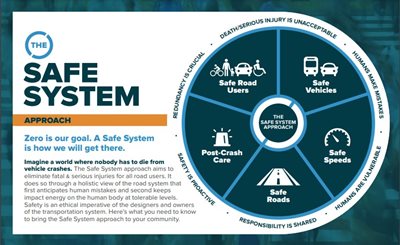“Imagine in the coming decades that not a single person in the United States dies in a traffic crash. Thinking about safety this way requires a paradigm shift in how we perceive the problem,” said Caroline Trueman, manager of the Safe Streets and Roads for All (SS4A) grant program at the Federal Highway Administration. She spoke at a joint meeting of the NJTPA’s Planning and Economic Development and Project Prioritization committees on Monday. According to Trueman, in 2019, 36,096 people were killed in crashes in the United States, including 6,205 pedestrians.
From 2009 through 2019, the number of pedestrians struck and killed in motor vehicle crashes increased by more than 50 percent, she said. To reverse the trend and reach the goal of zero deaths, Trueman urges the adoption of a Safe System approach: “Rather than accepting fatalities and serious injuries as a price for mobility, the philosophy of the Safe System approach is grounded in an ethical imperative that no one should be killed or injured when using the roadway system.”
She said that implementing the Safe System approach requires moving away from several traditional safety paradigms and instead:
- Seeks to prevent death and serious injuries rather than preventing crashes;
- Designs for human mistakes and limitations, trying to improve behavior;
- Attempts to reduce kinetic energy;
- Aims to share responsibility among system users, managers, and others rather than asserting that only individuals are responsible; and,
- Proactively identifies and addresses risks instead of reacting based on crash history.
 T
The Safe System approach is not a new concept, having existed in countries around the world for more than 30 years. It'
s based on a framework developed by other Safe System adopters outside the United States, including Sweden, the Netherlands, Australia, and New Zealand. Early adopters have seen marked decreases in traffic fatalities across their roadway systems — at least a 50 percent decline in fatalities, Trueman said. During the same period, fatalities in the U.S. dropped by only 11 percent. But she said efforts are underway to implement the Safe System approach more fully here.
In particular, she encouraged attendees to take advantage of the new SS4A grant program, which is accepting applications through September 15 at 5 p.m. (For additional information visit
njtpa.org/iija.)
The Safe System approach addresses the safety of all road users on an equal basis, including those who walk, bike, drive, ride transit, and travel by other modes. It acknowledges human limitations, and sets expectations for travelers who have the responsibility to operate, to the best of their ability, within the boundaries set by system managers. Education and enforcement can help to guide user behavior, Trueman said.
At the same time, she said, a key focus is to reduce death and serious injuries through design that accommodates human mistakes and injury tolerances. This includes designs that lower vehicle speeds like a
modern roundabout which forces drivers to slow down. Tru
eman said a reduction of 3 mph in average speed on a road with an average speed of 30 mph is expected to reduce crashes resulting injuries by 27 percent and fatalities by 49.
Over the past quarter-century, the town of Carmel, Indiana, has taken a Safe System approach to intersection design, converting more than 125 intersections to roundabouts. Carmel has seen serious injury crashes reduced by about 80 percent and the number of crashes overall has reduced by about 40 percent, according to Trueman.
“Roundabouts move people through intersections more efficiently and safer than stop signs or signalized intersections,” she said, adding they eliminate right angle and head-on crashes.
More information on the Safe System approach is available at safety.fhwa.dot.gov/zerodeaths